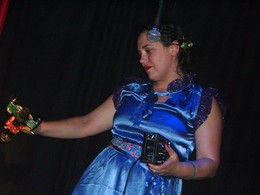Mirko Tobias Schäfer / Assistant Professor
University of Utrecht Department for Media and Culture Studies
Mirko Tobias Schäfer / Assistant Professor
University of Utrecht Department for Media and Culture Studies
In his opening talk Florian Cramer emphasized that the media design program at Piet Zwart requires students to develop both, sophisticated technical skills and analytical reflection on technological development, socio-political issues and art. In general the works presented at WORM were interesting, funny, and well executed. But especially four pieces stood out for their intellectual inspiration, quality and critical approach of rethinking technology and ways of being. The artists demonstrate a depth of examination of our technological lifeworld that is unfortunately missing in many other -far more professional- media art shows:
Walter Langelaar's Tangled_Object_Description_Overview (todo) is a recursive loop from Google Maps and Second Life to the exhibition place at WORM. A Second Life avatar enters Google Maps and finds on the geographical coordinates of the actual WORM building a fictional building taken from Second Life. The map is not the territory and keeps changing rapidly, since Langelaar dumps all kind of strange buildings from Second Life onto Google Maps.
The Cookie Census by Andrea Fiore is a web based tool for scanning and identifying cookies. The software is analyzing cookies, Doubleclick, Advertising.com, and Tacoda.net are sending to users reading news sites. It shows to how many websites they are sent, and gives information on the data the cookies are gathering as well as their date of expiration.
For her installation 'spectres' Audrey Samson recorded people talking about their personal mourning and losses. On location visitors can tune into these intimate talks on a radio set and will find them alternating with live recorded chatting in the WORM bar. The very intimate and private talking about mourning is transformed into a public space where the solitary reception situation of the visitor listening into the talks with headphones is again confronted with the common conversations taking place at the exhibition location.
Another impressive project is Jorrit Sybesma's printer installation Design Paradigm Shift: gradcatgen, a randomly in real time generated catalog of the graduation show. Sybesma had to reverse engineer many print processes in order to develop algorithms that would allow a complete random generation of the catalog. He emphasizes, the work is a critical notion towards the monolithic and deadlocked software principles and standards in graphic design and print processing.
'Paraphernalia' is a project by Nancy Mauro-Flude questioning aspects of live performance in the age of prerecorded sound and the cliché of laptop musicians. She uses dolls modified with game-pads as music instruments interfacing the Pure Data live procession language, and a complex set up with motion sensors on a tiny stage. Using the dolls as wireless instruments and background singers Nancy Mauro-Flude can perform on stage and simultaneously control her equipment. Moving and manipulating the dolls she evokes a vaudeville techno electro-clash version of a karaoke singing ventriloquist.

The graduation show of the Piet Zwart Institute master program in Media Design takes place at WORM Rotterdam. On Saturady July 7th Florian Cramer, head of the MA Media Design, gives an exclusive tour for the new media master students from Utrecht University. The exhibition covers a wide range of topics, from mash up web sites, over hardware hacking and critical software design to performance.
Piet Zwart Media Design Master, graduation show at WORM